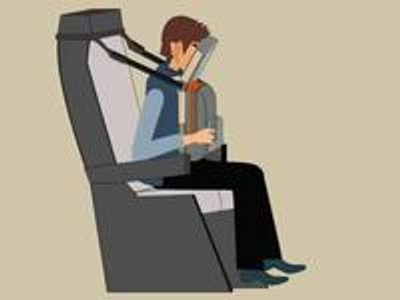Is Better Plane Sleep on the Horizon?
Bethaney Wallace on 7th Apr 2015
“I just had the greatest nap on the plane,” is something you rarely hear – if you’ve ever heard it at all. More often than not its, “The plane was so crowded,” or “I didn’t get a wink of sleep,” proving just how terrible travel rest can become. Planes just simply aren’t ideal for relaxation. They’re noisy, crowded, inevitably too hot, or too cold, and always in motion. Between the turbulence and strangers talking or making their way to the bathroom in between beverage deliveries, even the most tired passenger can find it hard to actually sleep.
But considering we’re often on planes for hours at a time, and at inconvenient hours, we want to sleep. Especially more so than eavesdropping or getting adjusted to various wind speeds. Because, when you’re able to obtain it, a good in-flight nap has plenty to offer. It can allow you to get caught up on rest and reduce the amount of sleep one loses while traveling. As well as to better prep ourselves for work or vacation – whatever it is that lies on the other side of our destination.
Though this has been an ongoing issue for years, Boeing has finally decided to do something about it. After all, those seats can only recline so far, and neck pillows practically count as their own carry on. Weighing all the options, the company decided to get to work on an upright sleeping device.

Boeings Mock Design of new sleeping apperatus Source: YouTube
How it Works
Attaching to the seat and supporting a passenger’s weight by the chest, it’s essentially a take on the modern-day massage table. Allowing the face to sit in an open space, but still be supported by the outer edges. The majority of a person’s weight, however would be held by their chest.
The head section is known as the “face relief aperture,” which will encompass the eyes, mouth, nose, as well as the chin. But most importantly, it will host a breathing hole so sleepers get plenty of oxygen and won’t wake themselves from trying to catch air. To date, the prototype is still being put together and has a working patent.
Sound uncomfortable? The mock-ups provided don’t look especially comfortable, either. After all, you’re placing your head in a plastic (albeit cushioned) device and then are expected to relax. But when the alternatives are throwing your head back or obtaining a cramp from leaning sideways, the front sleeper isn’t sounding so bad. Especially when it’s only your sleeping option for a few hours at a time.
Their Inspiration
Boeing stated the number one reason behind the invention is traveler comfort. Specifically to take care of seated sleeping, as alternatives haven’t allowed for continual rest. By combining the body’s natural tendency to lean forward, the device will “catch” us, while neck pillows or simply leaning sideways causes us to fall forward and wake with a jolt.
But by supporting that same weight, passengers can easily relax, even as they “fall” deeper into sleep.
So will it work? Will travelers be willing to place their heads in such devices? And the biggest question of all, will they be able to sleep? Time will tell … and likely bring on future changes to this new type of sleep system. However, for frequent travelers (even for those who travel once in a blue moon), it’s nice to know you have options. Airline companies are working to create better and more workable ways to support rest. Which, in the long term, means a more pleasant and restful traveling experience.
To learn more about Boeing’s new sleep device, check out this article: http://www.news.com.au/travel/travel-advice/boeing-issued-a-patent-for-an-upright-sleep-support-system/story-fn6yjmoc-1227295633891

